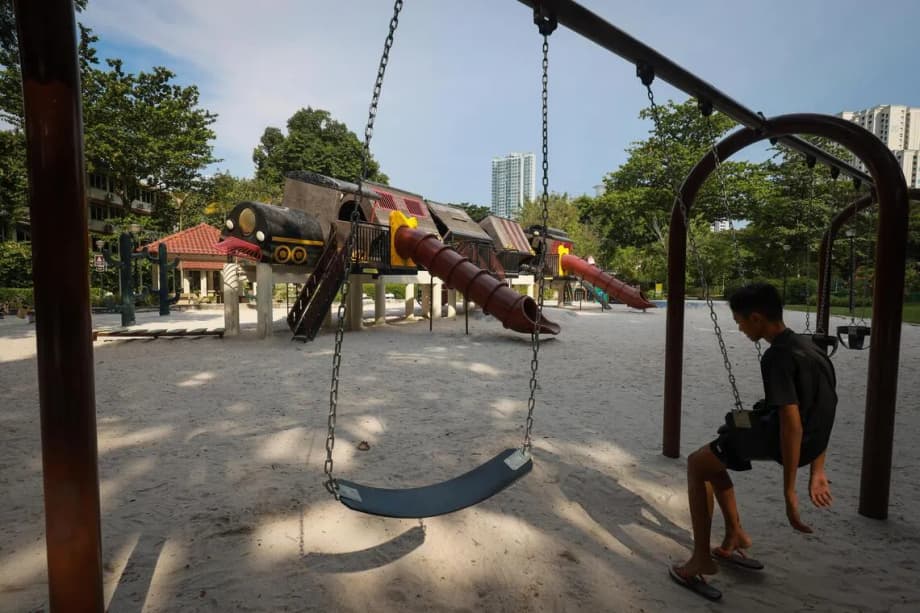A beloved fixture that is getting harder to find
Across housing estates and parks in Singapore, residents are searching in vain for swings. The classic back and forth ride once anchored almost every playground. Today it is rare. The absence became a public talking point after a parliamentary question by Sembawang GRC MP Ng Shi Xuan about how many playgrounds still feature swings or sand areas. The Ministry of National Development says there are about 2,800 public playgrounds nationwide, yet the number equipped with swings was not specified. That gap reflects the uneven presence of swings from estate to estate.
- A beloved fixture that is getting harder to find
- What the rules say about swings
- Space, surfaces and the shrinking swing
- What children gain from swinging, and why some experts worry
- The rise of themed and photo friendly playgrounds
- Where you can still find a good swing
- What could bring swings back into balance
- Key Points
Safety standards, space constraints and design trends help explain the change. Under the Singapore Standard SS 457 for playground equipment and surfacing, a swing must sit within a generous safety zone that is free of obstacles. The length of that zone is tied to the height of the swing. This makes the footprint of a swing large. In compact estates and small plots between blocks, that space is precious. Vendors say they can serve more children by installing climbing nets or multi play towers that fit inside the same area.
Parents and therapists are also questioning whether some modern designs over correct for risk, or lean too much toward decorative themes. Many families recall the challenge and joy that swings provide, from balance and timing to the thrill of momentum. The debate is less about nostalgia and more about how to balance safety with meaningful play that keeps children coming back.
What the rules say about swings
SS 457 aligns with international safety benchmarks such as EN 1176. It sets details from the height of top bars to the type of chains and seats. The most decisive requirement is the free movement zone. In simple terms, the clearance in front of and behind a seat should extend at least twice the height of the pivot point in each direction. If the pivot is 2 metres high, the clear zone can span up to 8 metres from end to end. Side clearance matters as well, and impact absorbing surfacing is required under and around the equipment.
Suppliers must certify that equipment meets the standard, and trained auditors inspect installations before handover. Checks continue through regular maintenance by agencies or town councils. That system has raised safety across estates, yet issues still surface. From 2022 to 2024, the authorities received an annual average of around 7,000 public feedback cases about playgrounds, most tied to broken components or cleanliness rather than accidents. The volume underscores how heavy daily use and weather affect equipment and surfaces, and why upkeep matters as much as design.
Space, surfaces and the shrinking swing
In a dense city, every square metre counts. A two bay swing frame, with the clear zones required by SS 457, can consume the space that might otherwise host a multi play tower with slides, bridges and climbing nets. In small plots this trade off is common. Designers often prioritise equipment that can hold many children at once and keep queues short. Swings tend to be single user, and that lowers their appeal where footfall is high.
Flooring has changed the landscape too. Sandpits once softened landings and offered open ended sensory play. Many estates replaced sand with rubber surfaces such as EPDM to reduce hidden hazards like sharp litter and to make cleaning easier. Rubber is durable and tidy, yet it limits digging, pouring and tactile exploration. That shift, along with the removal of firemen poles and merry go rounds in many sites, reflects a broader risk averse approach that narrows movement choices for children.
What children gain from swinging, and why some experts worry
Swings do more than entertain. The back and forth motion activates the vestibular system, which helps the brain regulate balance and movement. Pumping legs and gripping chains build core strength and coordination. Taking turns and matching rhythm with a partner build social skills. Occupational therapists warn that when play strips out challenge and varied sensory input, some children may find fewer chances to develop these skills, including those with additional needs.
That view does not argue for unsafe play. It calls for managed risk. Equipment that offers graduated challenge lets children test limits in small steps. A well planned swing bay can include seats for different ages, from bucket seats for toddlers to expression seats that face a parent, and wider basket seats that support children with limited trunk control. These choices help more children swing safely while still keeping the joy of movement.
The rise of themed and photo friendly playgrounds
Neighbourhood renewal brought in colourful towers, slides and nets, often set within themed designs that reference heritage or local icons. This shift replaced many older standalone elements. The intent is positive. Themes give a place identity, and larger central playgrounds serve as social hubs. Yet visual appeal can crowd out simpler equipment when space is tight. Some structures also feel unintuitive to new users, or encourage risky shortcuts if the movement paths are not obvious.
Residents in newer estates such as Punggol and Sengkang often report that upgraded playgrounds lean toward ship or adventure themes with many platforms but few swings. Parents are present more often and screen time at home competes for attention, so a single visit must feel exciting. Designers manage that pressure by packing in eye catching equipment that works for a short stop. Swings, which require space and turn taking, can be pushed aside in that equation.
Where you can still find a good swing
Swings have not vanished everywhere. Several parks and estates keep them in the mix, often within larger sites where space is less tight or where inclusive play is a design goal.
- Canberra Park in Sembawang, a well known swing hub with a large variety of seats including accessible options, a standing swing and a group rope swing, plus ramps and a rope obstacle course.
- Admiralty Park in Woodlands, home to dozens of slides and several swing types, including an expression swing that lets a child face a parent, plus sand areas for sensory play.
- Yishun Swings Park, a covered corner filled with bench swings, a basket swing and garden swings that invite both kids and adults, next to a small play area with slides and a see saw.
- Jubilee Park at Fort Canning, a biophilic play garden with swings, sandpits, climbing nets and a treehouse, with inclusive features for a range of abilities.
- Forest Ramble at Jurong Lake Gardens, a nature play area where basket swings and other movement elements sit among plants and boardwalks.
- Selected estates such as Tiong Bahru Park and Tampines GreenSpring, where swings remain part of the playground mix within themed designs.
What could bring swings back into balance
Balanced playgrounds mix age zones, risk levels and play types. Town councils and designers can reserve a small corner for a two bay swing and choose seats that serve toddlers, older children and those with additional needs. Shade, seating and separation from roads raise comfort and safety. Early input from therapists and child development specialists helps align layouts with how children actually move and learn. Residents can use public design exercises to request inclusive swings and better maintenance, not just new slides.
Key Points
- Swing sets are rarer in many estates, even as Singapore counts about 2,800 public playgrounds.
- SS 457 requires large safety zones for swings, which increases the footprint and reduces suitability for small plots.
- Public feedback averaged about 7,000 cases a year from 2022 to 2024, mostly about damage and cleanliness.
- The shift from sand to rubber surfacing cuts down on sensory play, while risk averse choices removed items like merry go rounds and firemen poles.
- Designers often choose multi user towers and nets to manage crowds, which can crowd out single user swings.
- Swings still exist in larger sites such as Canberra Park, Admiralty Park, Yishun Swings Park, Jubilee Park and Jurong Lake Gardens.
- Inclusive seats and parent child expression swings allow managed risk and wider access without sacrificing safety.




